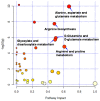Long-Term Mastication Changed Salivary Metabolomic Profiles
- PMID: 35888784
- PMCID: PMC9322701
- DOI: 10.3390/metabo12070660
Long-Term Mastication Changed Salivary Metabolomic Profiles
Abstract
Saliva is an ideal biofluid for monitoring oral and systemic health. Repeated mastication is a typical physical stimulus that improves salivary flow and oral hygiene. Recent metabolomic studies have shown the potential of salivary metabolomic components for various disease monitoring systems. Here, we evaluated the effect of long-term mastication on salivary metabolomic profiles. Young women with good oral hygiene (20.8 ± 0.3 years, n = 17) participated. They were prohibited from chewing gum during control periods (4 weeks each) and were instructed to chew a piece of gum base seven times a day for 10 min each time during the intervention period. Paired samples of unstimulated whole saliva collected on the last day of the control and intervention period were compared. Liquid chromatography−time-of-flight mass spectrometry successfully quantified 85 metabolites, of which 41 showed significant differences (p < 0.05, Wilcoxon paired test corrected by false discovery rate). Except for a few metabolites, such as citrate, most metabolites showed lower concentrations after the intervention. The pathways related to glycogenic amino acids, such as alanine, arginine, and glutamine, altered considerably. This study suggests that long-term mastication induces unstimulated salivary component-level changes.
Keywords: chewing; liquid chromatography–mass spectrometry; mastication; metabolomic profile; saliva.
Conflict of interest statement
This study was conducted with an appropriate joint research fund of Lotte Co., Ltd. Yoji Saeki and Minji Kim are basic researchers of Central Laboratory, Lotte Co., Ltd., and declare a conflict of interest. The other authors declare no conflict of interest.
Figures





References
LinkOut - more resources
Full Text Sources

